LOTUSLAND AT THE TATTERED COVER
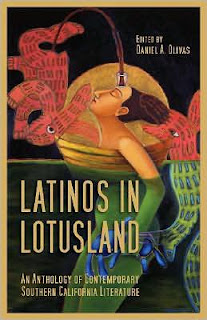
On May 21,
Rudy Ch. Garcia and I hosted a reading and signing event for
Latinos In Lotusland at the Colfax Avenue version of the
Tattered Cover Bookstore in Denver. The bookstore people, as always, were gracious and accommodating; the audience was attentive and eager to hear about this amazing collection of short stories that features more than thirty writers; and the night turned into one of those where everything fell into place and a great time was had by all. Camaraderie and affection filled the air as old friends greeted one another with enthusiastic hugs, while strangers shook hands and introduced themselves. Everyone was primed for a literary evening, and no one left disappointed.
A great crowd showed up for the event.
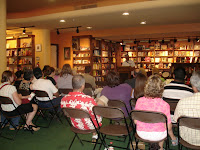
I opened the evening with some comments about
Daniel Olivas's original call for "provocative stories ... from social realism to
cuentos de fantasma and anything in between" as long as Los Angeles played an integral role. I pointed out that one of Daniel's goals was to bring together some of the "best contemporary Latino fiction" about Los Angeles. And then Rudy and I set out to demonstrate to the audience how well Daniel had succeeded in reaching his goal.
We had decided to give our audience as broad a taste as possible of the varied delicacies in the book by reading short samples from several of the stories. My selections focused on stories about writers, so I proceeded with the opening paragraphs from Luis J. Rodriguez's Miss East L.A., which made the audience laugh, even though there was a certain edge to the laughter. Then a few pithy paragraphs from Wayne Rapp's Just Seven Minutes that made the audience smile knowingly and laugh again; and finally a couple of paragraphs from my own The 405 Is Locked Down.
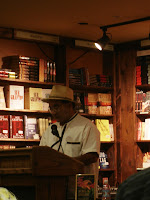
Rudy continued, in his inimitable style, with more short pieces. He opened with a page from
Luis Alberto Urrea's The White Girl, quickly moved to several paragraphs from
Frederick Luis Aldama (A Long Story Cut Short); came on strong with choice words from
Kathleen de Azevedo's The True Story; and finished with his own
LAX Confidential. We both wished we had more time to read more selections, but the ones we did manage to fit in were applauded enthusiastically by the audience. Later, several attendees told us that they appreciated the way we presented the stories, whetting their appetites, leaving them with the desire to hear more and, thus, to buy and read the book.
We answered questions: were there any pachuco stories in the collection (check out
Kid Zopilote by
Mario Suárez); why is profanity necessary in some stories and not in others (Rudy handled that); would we rather write short stories or novels (we like shorts, we like novels, we just want to write); is there a bias in the publishing world against writers from mid-America (h-m-m-m).
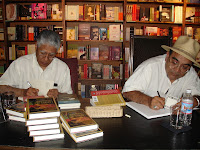
We finished by signing books for those who wanted autographs. We mingled a bit, took a few photos, then several of us ended up at the nearby
Neighborhood Flix Café bar, where old and sometimes class
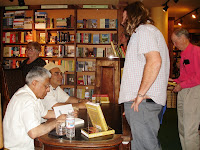
ic movies show continuously on the walls, and you can take your beverage of choice into the theater to watch movies like
The Favor, Anamorph and
21. We toasted the book, toasted one another, and speculated about another short story collection, maybe something like
Latinos in the Rocky Mountains. What a night.
 Rudy surrounded by his proud family at his first reading for a published story.NEW FROM NEW MEXICO PRESS
Rudy surrounded by his proud family at his first reading for a published story.NEW FROM NEW MEXICO PRESSThe following is from the
UNM Press Fall 2008 catalog:
 The Song of Jonah Gene Guerin
The Song of Jonah Gene GuerinIn this modern retelling of the Book of Jonah, Fr. Jon, like his biblical counterpart, rejects the call from God to his own “Nineveh.” In an ironic echoing of Jonah’s fate, the priest is swallowed up by a metaphorical whale and deposited on the very shores of the place he was determined to avoid. Nueve Niños, with its long-standing reputation for mistreating its pastors, is an alien world that will prove his ultimate testing ground. Through his slow, often reluctant immersion into the lives of the villagers, Fr. Jon eventually gains insight into himself and his ultimate calling.
Gene Guerin’s novel
Cottonwood Saints (UNM Press) won the
Mountains and Plains 2007 Regional Book Award for Adult Fiction and the
2006 Premio Aztlán for first-time Hispanic writers. Born and raised in New Mexico, he presently lives in Denver.
 ChupaCabra and the Roswell UFO
ChupaCabra and the Roswell UFO
Rudolfo Anaya
In this second ChupaCabra mystery, Professor Rosa Medina has just arrived in Santa Fe where she meets Nadine, a mysterious sixteen-year-old who insists that the two of them travel to Roswell, New Mexico. Nadine is convinced that C-Force, a secret government agency, has decoded the DNA of ChupaCabra and an extraterrestrial. If the two genomes are combined, a new and horrific life form will be created.
In this fast-paced mystery, Anaya expands the ChupaCabra folklore into a metaphor that deals with the new powers inherent in science. Is ChupaCabra a beast in Latino folktales, used to frighten children, or a lost species being manipulated by C-Force? Rosa’s life hangs in the balance as she and her young accomplice try to find a way to stop C-Force before its mad scientists create a monster.
Rudolfo Anaya has received numerous awards, including the
Premio Quinto Sol, the national Chicano literary award, the
National Medal of Arts for literature, the
PEN Center West Award for Fiction, the
American Book Award from The Before Columbus Foundation, the
Mexican Medal of Friendship from the Mexican Consulate, and the
Western Literature Association’s Distinguished Achievement Award.
 Juan the Bear and the Water of Life La Acequia de Juan del Oso
Juan the Bear and the Water of Life La Acequia de Juan del Oso
Retold and Translated by Enrique R. Lamadrid and Juan Estevan Arellano; Illustrated by Amy CórdovaLa Acequia del Rito y la Sierra in the Mora Valley is the highest and most famous traditional irrigation system in New Mexico. It carries water up and over a mountain ridge and across a sub-continental divide, from the tributaries of the Río Grande to the immense watershed of the Mora, Canadian, Arkansas, and Mississippi Rivers. The names and stories of those who created this acequia to sustain their communities have mostly been lost and replaced by myths and legends. Now, when children ask, some parents attribute the task of moving mountains and changing the course of rivers to Juan del Oso, the stouthearted man whose father was
a bear.
From the mountains of northern Spain to the Andes in South America, Spanish-speaking people have told ancient legends of Juan del Oso and his friends. In this children’s tale, agriculturalist Juan Estevan Arellano and folklorist Enrique Lamadrid share a unique version of a celebrated story that has been told in northern New Mexico for centuries.
Enrique R. Lamadrid, professor of Spanish folklore and literature at the University of New Mexico, was awarded the
Americo Paredes Prize in recognition of his work as a cultural activist. Juan Estevan Arellano, a native of Embudo, New Mexico, is a poet, artist, writer, and agronomist. He is an expert in traditional Spanish/Moorish agriculture and the sustaining of traditional crops originally brought to New Mexico from Europe and Central Mexico. Amy Córdova lives in Taos, New Mexico, where she is co-owner of
Enger-Córdova Fine Art. She is also an educator and has illustrated many children’s books.
Later.
Manuel Ramos
COLORADO
There are at least six Latina/o novelists who are Colorado based. Here are very brief summaries about five of them, in no particular order.

Abelardo Lalo Delgado
Lalo Delgado is best known, of course, as a premier Chicano poet (he passed away in 2004). Stupid America, a brilliant and succinct exposure of racism and its painful legacy, is a masterpiece of literary accomplishment, Chicano or otherwise. His one novel, Letters to Louise, is not as well-known but it does have a solid reputation and I think it deserves a broader audience. The book was published by Tonatiuh-Quinto Sol International in 1982, and copies can still be found in unique book stores and online. One of the gems of my sprawling library is a copy of this book in excellent condition with a very personal and friendly author's autograph. I noted in an earlier review that the novel "tells the story of a man struggling with the contradiction of a good person involved in a moral dilemma, an ordinary person making complex choices in order to live the life he thinks he should."
Alan Cheuse, in the New York Times, said: "The narrator of Delgado's novel is a middle-aged Chicano poet/social worker/administrator named Santiago Flores. His job as an expert on the problems of migrant workers takes him across the Southwest, and his search for himself carries him back into the world of his childhood. In the warm, slightly wacky letters that he writes to an unknown correspondent --possibly you? possibly me? -- there's a touch of Whitman and also a swatch of Cantinflas, and finally a great and appealing personality, a new and attractive voice. By peering over Abelardo's shoulder you may catch a glimpse of yourself in his highly polished Chicano mirror."
Gene Guerin
Gene Guerin's debut novel, Cottonwood Saints (University of New Mexico Press, 2005), won the Premio Aztlán and the Mountains and Plains Regional Book Award for Adult Fiction. I reviewed this book for La Bloga, where I noted that the "author says in the book's Acknowledgments that  Cottonwood Saints is a work of fiction but it is based on forty handwritten pages of reminiscences by his mother, Margaret Ortega Guerin. Without her memories there would be no book."
Cottonwood Saints is a work of fiction but it is based on forty handwritten pages of reminiscences by his mother, Margaret Ortega Guerin. Without her memories there would be no book."
I also said: "At its heart this book is about the essential strength and dignity of hard-working, unpretentious people. In that way this book compares favorably, in tone, depth and sweep, to Luis J. Rodriguez's family saga of steelworkers in Twentieth Century Los Angeles, Music of the Mill (Rayo, 2005). The New Mexican rural poor of Cottonwood Saints overcome hardship and tragedy; raise families and provide for their children against all obstacles, natural and man made; they love, hate and disappoint; they overcome or succumb, yet they manage to leave something to pass on, something to cherish, in the same ways as Rodriguez's urban working class characters also survived and endured. They lived stories that cried out to be told."

Mario Acevedo
Mario Acevedo has staked out the Chicano-private eye-war vet-vampire turf and made it his special place. His first two books of a projected three book series have entertained and amused readers across the country. La Bloga has featured Acevedo several times -- interviews, reviews, and he did a guest post for us, too -- and at this point we eagerly wait for his next piece in the series. The first, Nymphos of Rocky Flats (Rayo, 2006), garnered this praise from La Bloga's Daniel Olivas:
"Acevedo gleefully debunks vampire lore and creates new rules of the game with a bit of romance thrown in for good measure. In the end, The Nymphos of Rocky Flats delivers fast paced fun topped off with wry humor and dead-on social commentary. One wonders who will play Felix Gomez in the screen adaptation."

His second, X-Rated Bloodsuckers (Rayo, 2007), also received rave reviews, including this from La Bloga's Michael Sedano:
"X-Rated Bloodsuckers will make an excellent, if perhaps ironic, gift for Easter. Harper Collins’ Rayo imprint has the novel scheduled for a March 2007 release. Outright hilarity in places, downright revulsion in others, e.g. rat chorizo and coffee mixed with Type B, and an involving yarn make it a standout. Hopefully, a recipient won’t be superstitious, but at any rate, the engaging character of Felix Gomez will win you as many friends as you give copies to."
The third Felix Gomez book, The Undead Kama Sutra, is set for a March, 2008 release.

Lynda Sandoval
Lynda Sandoval is a former police officer-turned fiction writer with fourteen book sales to her credit.
Sandoval writes women's fiction for HarperCollins Rayo; romance for Silhouette Special Edition; romantic suspense for Silhouette Intimate Moments; and young adult novels for Simon & Schuster.
Her books have won awards such as the 2000 Rising Star, the 2002 Golden Quill, and the 2002 Beacon—all sponsored by regional chapters of Romance Writers of America. She was also a finalist in the 2002 Booksellers Best, and a two-time Romance Writers of America Golden Heart finalist prior to selling.
Her novels include
Chicks Ahoy (Simon & Schuster, 2006);
Unsettling (Rayo, 2004); and
And Then There Were Three (Harlequin, 2003). She also wrote
True Blue: An Insider's Guide to Street Cops for Writers (Gryphon, 1999).
 Aaron A. Abeyta
Aaron A. Abeyta A few weeks ago
A few weeks ago I interviewed Aaron A. Abeyta and offered some comments about his debut novel,
Rise, Do Not Be Afraid (Ghost Road Press, 2007). Abeyta's interview is worth looking at if you haven't read it yet. For example, here is his take on being a storyteller:
"I learned early on, mostly from my abuelo, that a story is a living thing. I don’t ever remember hearing a story that began at A and ended at Z. I didn’t grow up with typical plot structures as a model. My mom didn’t read Mother Goose to me, or anything of the sort. I tell people that and they look at me like I was abused, as if to say that my parents not reading to me was some sort of 20th century crime. I never felt deprived, however. Everyone around me told great stories, and those were my bedtime stories. For example, my abuelito would tell a story and then a few weeks later I would hear the same story from the sheepherder and they were remarkably different, yet essentially the same. The teller of the story was always the heart, the information the blood and the listener the soul. I try and remain true to this model, not only in the novel but in all my writing. I guess my people were born of circles because that’s the way we still communicate."
Abeyta teaches English at Adams State College in Alamosa. He also has published two poetry collections,
As Orion Falls (Ghost Road Press, 2005), and
Colcha (University Press of Colorado, 2000).
Colcha won an American Book Award and the Colorado Book Award.
Rudolfo Anaya sent information about his participation in
The Big Read, so I checked out the website and pulled the following (all quoted from
http://www.neabigread.org/):
"The Big Read is an initiative of the National Endowment for the Arts, designed to restore reading to the center of American culture. The NEA presents The Big Read in partnership with the Institute of Museum and Library Services and in cooperation with Arts Midwest. The Big Read brings together partners across the country to encourage reading for pleasure and enlightenment.
"The Big Read answers a big need. Reading at Risk: A Survey of Literary Reading in America, a 2004 report by the National Endowment for the Arts, found that not only is literary reading in America declining rapidly among all groups, but that the rate of decline has accelerated, especially among the young. The concerned citizen in search of good news about American literary culture would study the pages of this report in vain.
"The Big Read aims to address this crisis squarely and effectively. It provides citizens with the opportunity to read and discuss a single book within their communities. The initiative includes innovative reading programs in selected cities and towns, comprehensive resources for discussing classic literature, an ambitious national publicity campaign, and an extensive Web site providing comprehensive information on authors and their works.
"Each community event lasts approximately one month and includes a kick-off event to launch the program locally, ideally attended by the mayor and other local luminaries; major events devoted specifically to the book (panel discussions, author reading, and the like); events using the book as a point of departure (film screenings, theatrical readings, and so forth); and book discussions in diverse locations and aimed at a wide range of audiences."

I've seen the discussion and study materials for Bless Me, Ultima, and I was impressed. These include a Teacher's Guide and a Reader's Guide, which look to me as though they are very good tools for a deeper understanding of the novel.
Manuel Ramos
A review of the award-winning New Mexico novel, Cottonwood Saints, then a few bits and pieces of news, and a contest!
COTTONWOOD SAINTS
Gene Guerin
University of New Mexico Press, 2005

Gene Guerin's family saga has been awarded the 2006 Premio Aztlán and the 2007 Mountain & Plains Regional Book Award for Adult Fiction. The Denver-based author says in the book's Acknowledgments that Cottonwood Saints is a work of fiction but it is based on forty handwritten pages of reminiscences by his mother, Margaret Ortega Guerin. "Without her memories there would be no book." To add to the feeling of authenticity, the book's cover photo is labeled Margarita's first communion, courtesy of the author. Yet, Guerin confesses, also in his Acknowledgments, that he "assumed the novelist's prerogative of exaggeration, fabrication and manipulation for the sole purpose of a good story." And a good story it turned out to be.
Guerin takes his time with his tale. There is no hurried narrative, no clipped or abstract language to indirectly evoke a feeling or set a scene. The emotions and descriptions are spelled out, the details are abundant and the pace is leisurely, although there is plenty going on in these pages. The book covers the years from 1913, when Margarita Juana Galván is born, until the Epilogue in 1990. In other words, Margarita's life parallels the major ebbs and flows of the turbulent Twentieth Century.
In her early years she enjoys a bucolic, almost fairy-tale existence with her loving aunt, Adela, and devoted servant, Nasha, in a magical life close to nature and the spirituality of Nasha. But that existence is temporary and eventually she is thrust into the harsh reality of her hard-working but poor parents who struggle through difficult times in Las Vegas, New Mexico and Denver. Margarita's life becomes a series of encounters with hunger, racism, and illness, as well as a constant state of conflict because of her strained and distant relationship with her cold, bitter mother. Only when the family returns to Las Vegas where the father somewhat successfully operates a lumber business does Margarita start to come in to her own. Her intelligence, independence and ambition collide with her mother's dark view of life and her neighbors' resentment and jealousy. These are central themes in Margarita's life -- unfulfilled dreams and failures by those she trusts.
Married life brings with it more pain and disappointment. Her husband, Miguel Galván, is a dozen years older, an industrious, solemn man intimidated by his more flamboyant and reckless brothers. He is described as the victim of "bad timing" that began on his birth date, January 2, 1901, "a day late to bask in whatever celebrity was attendant to being a New Year's baby, and more significantly in this case, a New Century baby. ... Christmas and New Year are over. No one wants any more parties. No one wants to give any more presents. Who wants to celebrate anything on January 2." He works diligently and faithfully as a butcher in the business he owns with one of his brothers, but only Margarita sees that the brother takes advantage of Miguel. The brother and his wife live the good life with new cars and treasured refrigerators, while Miguel and Margarita can barely make ends meet. But the most tragic event in Margarita's life is the loss of her favored son, Miguelito. That death haunts her and clouds the rest of her life and the life of the son who was born after Miguelito, Michael.
The book finishes with the story of Michael's tortured years as an alcoholic priest and the final sad acts in the life of Margarita and her husband Miguel.
The tapestry of the Twentieth Century flaps in the background of Margarita's story, and Guerin appropriately touches on the integral role of the New Mexican Hispanos in such events: World War I and II, especially the heroism and sacrifices of the New Mexico National Guard when the Japanese overran the Philippines; the worldwide Spanish Flu pandemic that killed forty million people worldwide including thousands in New Mexico; Ku Klux Klan marches in the streets of Denver, shouting hatred and hostility against all non-whites; a boxing match held in Las Vegas between Jack Johnson and a great white hope from Pueblo, Colorado; the economic and social devastation of the Great Depression. The history accurately frames the day-to-day plots and subplots in Margarita's life.
There are many sad and tragic events in this book -- betrayal, murder, fatal accidents and deadly diseases. A few lines from the book exemplify the sadness: "From the age of nine to the age of twelve, Margarita Juana had occasion to cry every day. The general cause of her misery was her exile to the lumber camp of her father, Leopoldo. The immediate instrument of her pain and sorrow was her mother, Tamar." But this is not a sad book. It is a very human book with all the drama and melodrama that humans require in their lives, and then some.
At its heart this book is about the essential strength and dignity of hard-working, unpretentious people. In that way this book compares favorably, in tone, depth and sweep, to Luis J. Rodriguez's family saga of steelworkers in Twentieth Century Los Angeles, Music of the Mill (Rayo, 2005). The New Mexican rural poor of Cottonwood Saints overcome hardship and tragedy; raise families and provide for their children against all obstacles, natural and man made; they love, hate and disappoint; they overcome or succumb, yet they manage to leave something to pass on, something to cherish, in the same ways as Rodriguez's urban working class characters also survived and endured. They lived stories that cried out to be told. Guerin has done that with this book that he dedicated to his mother. These are the stories that have to be preserved.

MARIO ACEVEDO AT THE TATTERED COVER
Wednesday, March 21, 7:30 pm, Historic LoDo
Mario Acevedo will read from and sign X-Rated Blood Suckers (Rayo), the sequel to his debut Felix the Vampire detective novel The Nymphos of Rocky Flats. Those of us in the Denver area are already planning to attend. See you there.
PISTOLERA
I pass on the following news about the Pistolera video from Daniela Capistrano, Director and Producer:
"The Pistolera video Cazador that I directed/produced will debut [February 28] on METV in Austin, TX on the show Sonido Boombox. They have it posted on their show calendar: http://www.myspace.com/sonidoboombox.
"The video will also be included in a DVD compilation about immigration marches around the country. The company is based in Vancouver, CA and is being spearheaded by Frank Lopez, formerly of Democracy Now! in NYC. It will be distributed to pro-immigrant groups in April around the country to get them amped about the marches that are to take place this May. I am very proud of this and hope it inspires many.
"The video has also been sent to: LA TV, Mun2, MTV Espanol, World Beats, and Democracy Now!, and New York Noise.
"Will keep you posted as we get more adds.
"Here is a preview link to the actual video (lots of bar/tone in the beginning, you have to wait a bit):
"Thanks,
Daniela Capistrano
http://danielacapistrano.wordpress.com"
WHO ROTE DAT?I am offering a free lifetime subscription to La Bloga to the first person who can tell me the author of the following lines of Western Haiku:
Missing a kick
at the icebox door
it closed anyway.
Later.
 On May 21, Rudy Ch. Garcia and I hosted a reading and signing event for Latinos In Lotusland at the Colfax Avenue version of the Tattered Cover Bookstore in Denver. The bookstore people, as always, were gracious and accommodating; the audience was attentive and eager to hear about this amazing collection of short stories that features more than thirty writers; and the night turned into one of those where everything fell into place and a great time was had by all. Camaraderie and affection filled the air as old friends greeted one another with enthusiastic hugs, while strangers shook hands and introduced themselves. Everyone was primed for a literary evening, and no one left disappointed.
On May 21, Rudy Ch. Garcia and I hosted a reading and signing event for Latinos In Lotusland at the Colfax Avenue version of the Tattered Cover Bookstore in Denver. The bookstore people, as always, were gracious and accommodating; the audience was attentive and eager to hear about this amazing collection of short stories that features more than thirty writers; and the night turned into one of those where everything fell into place and a great time was had by all. Camaraderie and affection filled the air as old friends greeted one another with enthusiastic hugs, while strangers shook hands and introduced themselves. Everyone was primed for a literary evening, and no one left disappointed.


 ic movies show continuously on the walls, and you can take your beverage of choice into the theater to watch movies like The Favor, Anamorph and 21. We toasted the book, toasted one another, and speculated about another short story collection, maybe something like Latinos in the Rocky Mountains. What a night.
ic movies show continuously on the walls, and you can take your beverage of choice into the theater to watch movies like The Favor, Anamorph and 21. We toasted the book, toasted one another, and speculated about another short story collection, maybe something like Latinos in the Rocky Mountains. What a night.

 ChupaCabra and the Roswell UFO
ChupaCabra and the Roswell UFO















Addendum:
Tattered Cover rarely does readings for short story collections because turnout is usually low.
They informed us this event was the best turnout ever!
My advice for first-time authors doing a booksigning: come prepared with some inspirational messages because you will be asked to come up with something--on the spot!
RudyG
What a wonderful report and great photos of the book reading! I wish I could have been there but our son turned 18 that day and life in Lotusland has been busy of late. You vatos make me so proud and, yet again, you've confirmed the importance of this project. Please send my thank yous to the fine people at the Tattered Cover.